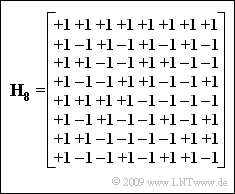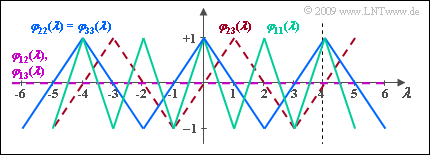Exercise 5.4: Walsh Functions (PCCF, PACF)
The so-called "Walsh functions", which can be constructed by means of the Hadamard matrix, are often used for band spreading and band compression. Starting from the matrix
- $${\mathbf{H}_{2}} = \left[ \begin{array}{ccc} +1 & +1 \\ +1 & -1 \end{array} \right] $$
the further Hadamard matrices $ {\mathbf{H}_{4}}$, $ {\mathbf{H}_{8}}$, etc. can be derived by the following recursion:
- $$ {\mathbf{H}_{2J}} = \left[ \begin{array}{ccc} \mathbf{H}_J & \mathbf{H}_J \\ \mathbf{H}_J & -\mathbf{H}_J \end{array} \right] \hspace{0.05cm}.$$
The diagram shows the matrix $ {\mathbf{H}_{8}}$ for the spreading factor $J = 8$. From this we can derive the spreading sequences
- $$ \langle w_\nu^{(1)}\rangle = {+\hspace{-0.05cm}1}\hspace{0.15cm} {-\hspace{-0.05cm}1} \hspace{0.15cm} {+\hspace{-0.05cm}1}\hspace{0.15cm} {-\hspace{-0.05cm}1} \hspace{0.15cm}{+\hspace{-0.05cm}1}\hspace{0.15cm} {-\hspace{-0.05cm}1} \hspace{0.15cm}{+\hspace{-0.05cm}1}\hspace{0.15cm} {-\hspace{-0.05cm}1} \hspace{0.05cm},$$
- $$ \langle w_\nu^{(2)}\rangle = {+\hspace{-0.05cm}1}\hspace{0.15cm} {+\hspace{-0.05cm}1} \hspace{0.15cm} {-\hspace{-0.05cm}1}\hspace{0.15cm} {-\hspace{-0.05cm}1} \hspace{0.15cm}{+\hspace{-0.05cm}1}\hspace{0.15cm} {+\hspace{-0.05cm}1} \hspace{0.15cm}{-\hspace{-0.05cm}1}\hspace{0.15cm} {-\hspace{-0.05cm}1} \hspace{0.05cm},$$
- $$...$$
- $$\langle w_\nu^{(7)}\rangle = {+\hspace{-0.05cm}1}\hspace{0.15cm} {-\hspace{-0.05cm}1} \hspace{0.15cm} {-\hspace{-0.05cm}1}\hspace{0.15cm} {+\hspace{-0.05cm}1} \hspace{0.15cm}{-\hspace{-0.05cm}1}\hspace{0.15cm} {+\hspace{-0.05cm}1} \hspace{0.15cm}{+\hspace{-0.05cm}1}\hspace{0.15cm} {-\hspace{-0.05cm}1} \hspace{0.05cm}$$
for seven CDMA subscribers. The spreading sequence $ \langle w_\nu^{(0)}\rangle$ corresponding to the first row in the Hadamard matrix is usually not assigned because it does not spread.
The questions mostly refer to the spreading factor $J = 4$. Thus, correspondingly, a maximum of three CDMA subscribers can be supplied with the spreading sequences $ \langle w_\nu^{(1)}\rangle$, $ \langle w_\nu^{(2)}\rangle$ and $ \langle w_\nu^{(3)}\rangle$, which result from the second, third and fourth rows of the matrix $ {\mathbf{H}_{4}}$.
Regarding the correlation functions, the following nomenclature shall apply in this exercise:
- The periodic cross-correlation function $\rm (PCCF)$ between the sequences $ \langle w_\nu^{(i)}\rangle$ and $ \langle w_\nu^{(j)}\rangle$ is denoted by $φ_{ij}(λ)$. Here:
- $${\it \varphi}_{ij}(\lambda) = {\rm E}\left [ w_{\nu}^{(i)} \cdot w_{\nu+ \lambda}^{(j)} \right ] \hspace{0.05cm}.$$
- If $φ_{ij} \equiv 0$ $($that is: $φ_{ij}(λ) = 0$ for all values of $λ)$, the CDMA subscribers do not interfere with each other, even if they have different propagation times.
- If at least $φ_{ij}({\it λ} = 0) = 0$ applies, then no interference occurs, at least in synchronous CDMA operation $($no or equal propagation times of all subscribers$).$
- The periodic auto-correlation function $\rm (PACF)$ of the Walsh function $ \langle w_\nu^{(i)}\rangle$ is denoted by $φ_{ii}(λ)$, and it holds:
- $${\it \varphi}_{ii}(\lambda) = {\rm E}\left [ w_{\nu}^{(i)} \cdot w_{\nu+ \lambda}^{(i)} \right ] \hspace{0.05cm}.$$
Notes:
- The exercise belongs to the chapter Spreading Sequences for CDMA.
- Reference is made in particular to the section Walsh functions in the theory part.
- We would also like to draw your attention to the interactive applet Generation of Walsh functions.
- The abscissa is normalized to the chip duration $T_c$. This means that $λ = 1$ actually describes a shift by the delay time $τ = T_c$.
Questions
Solution
- The matrix $ {\mathbf{H}_{4}}$ is the upper left submatrix of $ {\mathbf{H}_{8}}$.
- The spreading sequences result from the rows 2, 3 and 4 of $ {\mathbf{H}_{4}}$, and agree with the given sequences.
(2) Solutions 1, 2 and 3 are correct:
- According to the equations in the data section, the following holds:
- $${\it \varphi}_{12}(\lambda = 0) = 1/4 \cdot \left [ (+1) \cdot (+1) + (-1) \cdot (+1) + (+1) \cdot (-1) + (-1) \cdot (-1) \right ] = 0\hspace{0.05cm},$$
- $${\it \varphi}_{13}(\lambda = 0) = 1/4\cdot \left [ (+1) \cdot (+1) + (-1) \cdot (-1) + (+1) \cdot (-1) + (-1) \cdot (+1) \right ] = 0\hspace{0.05cm},$$
- $${\it \varphi}_{23}(\lambda = 0) =1/4 \cdot \left [ (+1) \cdot (+1) + (+1) \cdot (-1) + (-1) \cdot (-1) + (-1) \cdot (+1) \right ] = 0\hspace{0.05cm}.$$
- Also, for larger values of $J$, for $i ≠ j$ the PCCF value is always $φ_{ij}(λ = 0)= 0$.
- It follows: In synchronous CDMA, the subscribers do not interfere with each other.
(3) Solutions 1 and 2 are correct:
- For all values of $λ$, the PCCF is $φ_{12}(λ) = 0$, as shown by the following lines:
- $$\langle w_\nu^{(1)}\rangle = {+\hspace{-0.05cm}1}\hspace{0.15cm} {-\hspace{-0.05cm}1} \hspace{0.15cm} {+\hspace{-0.05cm}1}\hspace{0.15cm} {-\hspace{-0.05cm}1} \hspace{0.05cm},$$ $$\langle w_\nu^{(2)}\rangle = {+\hspace{-0.05cm}1}\hspace{0.15cm} {+\hspace{-0.05cm}1} \hspace{0.15cm} {-\hspace{-0.05cm}1}\hspace{0.15cm} {-\hspace{-0.05cm}1} \hspace{0.05cm}, \hspace{0.3cm}{\rm product\hspace{0.1cm} with \hspace{0.1cm}}\langle w_\nu^{(1)}\rangle: {+\hspace{-0.05cm}1}\hspace{0.15cm} {-\hspace{-0.05cm}1} \hspace{0.15cm} {-\hspace{-0.05cm}1}\hspace{0.15cm} {+\hspace{-0.05cm}1} \hspace{0.05cm},$$
- $$\langle w_{\nu+1}^{(2)}\rangle = {-\hspace{-0.05cm}1}\hspace{0.15cm} {+\hspace{-0.05cm}1} \hspace{0.15cm} {+\hspace{-0.05cm}1}\hspace{0.15cm} {-\hspace{-0.05cm}1} \hspace{0.05cm}, \hspace{0.3cm}{\rm product\hspace{0.1cm} with \hspace{0.1cm}}\langle w_\nu^{(1)}\rangle: {-\hspace{-0.05cm}1}\hspace{0.15cm} {-\hspace{-0.05cm}1} \hspace{0.15cm} {+\hspace{-0.05cm}1}\hspace{0.15cm} {+\hspace{-0.05cm}1} \hspace{0.05cm},$$
- $$\langle w_{\nu+2}^{(2)}\rangle = {-\hspace{-0.05cm}1}\hspace{0.15cm} {-\hspace{-0.05cm}1} \hspace{0.15cm} {+\hspace{-0.05cm}1}\hspace{0.15cm} {+\hspace{-0.05cm}1} \hspace{0.05cm},\hspace{0.3cm}{\rm product\hspace{0.1cm} with \hspace{0.1cm}}\langle w_\nu^{(1)}\rangle: {-\hspace{-0.05cm}1}\hspace{0.15cm} {+\hspace{-0.05cm}1} \hspace{0.15cm} {+\hspace{-0.05cm}1}\hspace{0.15cm} {-\hspace{-0.05cm}1} \hspace{0.05cm},$$
- $$\langle w_{\nu+3}^{(2)}\rangle = {+\hspace{-0.05cm}1}\hspace{0.15cm} {-\hspace{-0.05cm}1} \hspace{0.15cm} {-\hspace{-0.05cm}1}\hspace{0.15cm} {+\hspace{-0.05cm}1} \hspace{0.05cm},\hspace{0.3cm}{\rm product\hspace{0.1cm} with \hspace{0.1cm}}\langle w_\nu^{(1)}\rangle: {+\hspace{-0.05cm}1}\hspace{0.15cm} {+\hspace{-0.05cm}1} \hspace{0.15cm} {-\hspace{-0.05cm}1}\hspace{0.15cm} {-\hspace{-0.05cm}1} \hspace{0.05cm},$$
- $$\langle w_{\nu+4}^{(2)}\rangle = {+\hspace{-0.05cm}1}\hspace{0.15cm} {+\hspace{-0.05cm}1} \hspace{0.15cm} {-\hspace{-0.05cm}1}\hspace{0.15cm} {-\hspace{-0.05cm}1} = \langle w_\nu^{(2)}\rangle \hspace{0.05cm}.$$
- The same is true for the PCCF $φ_{13}(λ)$.
- In contrast, for the PCCF between the sequences $ \langle w_\nu^{(2)}\rangle$ and $ \langle w_\nu^{(3)}\rangle$ we obtain:
- $${\it \varphi}_{23}(\lambda ) = \left\{ \begin{array}{c}0 \\+1\\ -1 \\ \end{array} \right. \begin{array}{*{10}c} {\rm{for}} \\ {\rm{for}} \\ {\rm{for}} \\ \end{array} \begin{array}{*{20}c} \lambda = 0, \pm 2, \pm 4,\pm 6, ... \hspace{0.05cm}, \\ \hspace{0.14cm} \lambda = ... \hspace{0.05cm} , -3, +1, +5, ... \hspace{0.05cm}, \\ \hspace{0.14cm} \lambda = ... \hspace{0.05cm} , -5, -1, +3, ... \hspace{0.05cm}. \\ \end{array}$$
- This means: if the signal from subscriber $3$ is delayed by one spreading chip with respect to subscriber $2$ or vice versa, the subscribers can no longer be separated and there is a significant increase in the error probability.
- In the diagram, the PKKF curves are drawn in dashed lines (violet and red).
(4) Statements 1, 2 and 4 are correct:
- Since the Walsh function no. $1$ is periodic with $T_0 = 2T_c$, the PACF is also periodic with $λ = 2$.
- The second statement is correct, as shown by the following calculation (green curve):
- $${\it \varphi}_{11}(\lambda = 0) = 1/4 \cdot \big [ (+1) \cdot (+1) + (-1) \cdot (-1) + (+1) \cdot (+1) + (-1) \cdot (-1) \big ] = +1\hspace{0.05cm},$$
- $${\it \varphi}_{11}(\lambda = 1) = 1/4 \cdot \big [ (+1) \cdot (-1) + (+1) \cdot (-1) + (+1) \cdot (-1) + (+1) \cdot (-1) \big ] = -1\hspace{0.05cm}.$$
- Since the two Walsh functions no. $2$ and $3$ differ only by a shift around $T_c$ and a phase in the PACF has no effect in principle, in fact, according to the last statement, $φ_{33}(λ) = φ_{22}(λ)$. These two PACF functions are plotted in blue.
- In contrast, $φ_{22}(λ)$ differs from $φ_{11}(λ)$ by a different periodicity: $φ_{22}(λ) = φ_{33}(λ)$ is twice as wide as $φ_{11}(λ)$.

